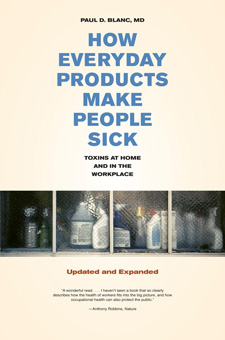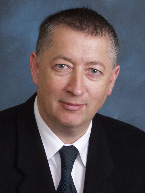Re-Released Book Cites Historical Cases Leading to Today's Toxic Environment

By Kate Rauch
Two-thousand year ago, the Roman architect, Vitruvias, warned of the dangers of using lead pipes. “Water from clay pipes is much more wholesome than that which is conducted through lead pipes, for lead is found to be harmful,” he wrote in a treatise for “Ten Books on Architecture,” around 25 BC.
Vitruvias went on: “When lead is smelted in casting, the fumes from it settle upon their members and day after day burn out and take away all the virtues of the blood from their limbs.”
To Paul Blanc, MD, Endowed Chair in Occupational and Environmental Medicine, this nugget of ancient history should stand as an “I told you so,” to 21st Century professionals working on current lead exposure problems, such as the recent rash of lead contaminated toys and lead-leaching Astro turf.
One would think, Blanc believes, that over the course of a couple thousand years, society would get a handle on the dangers of lead. Instead, he maintains, significant lessons from the history of toxins such as lead get lost through the years, obliterated by consumerism—or the supply and demand for more, better, faster and cheaper things.

Paul Blanc
With amazing detail that belies the meticulous scientist and nitpicky historian that he is, Blanc reveals the tell-tale history of today’s risky chemicals in his recently re-released book “How Everyday Products Make People Sick: Toxins at Home and in the Workplace” (University of California Press).
First published in 2007, the book’s title doesn’t really do its contents justice. Far more than a guide to today’s lurking toxic dangers, “How Everyday Products Make People Sick” is a dense and carefully-cited trip back in time with numerous common chemicals, visiting the often striking accidents, illnesses and deaths that prove their culpability as potential bad agents.
A few of the topics examined include:
- “Superglues” – can cause asthma and other potentially fatal breathing conditions. (There are also cases of superglue being mistaken for eye drops.)
- Household bleach – can cause chlorine gas poisoning when mixed with other cleaning products
- Rayon and other synthetic textiles – the manufacturing process is linked to carbon disulfide poisoning marked by psychosis, heart problems, and other serious symptoms
“How Everyday Products Make People Sick” isn’t a Luddite call to reject contemporary ways and return to a preindustrial lifestyle. In fact, in an often witty manner that draws from ancient texts as well as contemporary rock music, Blanc documents health risks back to Neolithic stone carvers with repetitive strain injuries.
The book is more of a scholarly knuckle-rapping to today’s toxic oversight efforts for characteristically ignoring history and tackling age-old problems as if they’re new. Blanc views this revisionist, short-term memory mentality as absurd in the face of a long road of science that’s invaluable to establishing safe chemical uses. In his own words:
Q&A
Q: Your book was first published in 2007 (to great reviews); why did you decide to re-release it in 2009?
A: So much had transpired in a short time – including emerging issues mentioned in 2007 that have since become headlines, such as lead in toys, “popcorn lung” from the artificial flavoring agent diacetyl, mine disasters, US soldiers exposed to home-made chlorine-bombs; and even the BP oil spill.
Q: With occupational and environmental exposures, why is this historical view so important?
A: The old adage that without learning from the past we are condemned to repeat it is very applicable to health and safety on the job and in the environment, including in the home environment.
Q: You discuss the tendency for environmental revisionist thinking, where society, or at least governments and corporations, tend to “forget” well-documented hazards learned from the past. Why don’t these toxic lessons stick?
A: It is certainly in the vested interest of those who profit from these products to have people forget – it is a kind of consumer un-marketing. Since physicians and nurses are rarely educated about these issues there is little continuity on the health care treatment side either.
Q: Why should doctors and medical students read your book?
A: Not just physician but nurses and hygienists and lawyers and policy makers should read it. This is not a narrow “medicalized” problem, but a public health issue in the broadest sense.
Q: What can lay-readers take away from your book?
A: The general reader, I hope, can be motivated to become a more engaged citizen – working together with others on a societal level to make things better – including pushing our elected representatives to act.
Q: How can governments do a better job of protecting citizens?
A: Effective regulatory efforts require a public-protective pro-active strategy – coordinated and with “teeth” – the ongoing Gulf oil fiasco underscores this better than any other recent example.
Q. You organized and chaired the 4th International Conference on the History of Occupational and Environmental Health [PDF] (June 19 – 22) here at UCSF. What do you wish the “outside world” can learn from this conference?
A: The history of these problems is long and rich; there is no magic dividing line between the consumer and the workplace, and the workplace and environment – everything is interconnected. Health care providers have a lot to teach historians and historians a lot to teach health care providers.
Q. Do you see yourself equally a historian and a medical doctor?
A: I see myself as a physician researcher and clinician with a keen awareness that if we ignore history we do so at our own peril.
Related Links:
University of California Press
UCSF Professor Paul D. Blanc Writes Book: How Everyday Products Make People Sick
UCSF Today, November 14, 2006